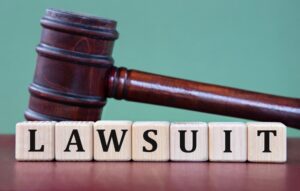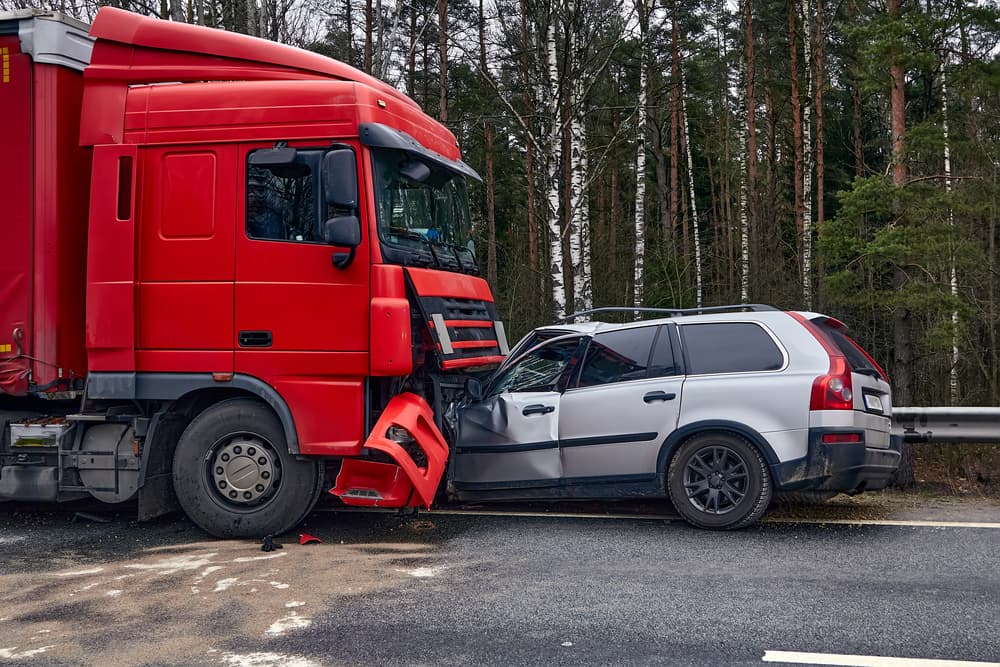Truck accidents frequently happen when truck drivers and trucking companies are negligent, such as by violating road rules or motor carrier regulations. When accident victims suffer injuries, they may be eligible to recover compensation for their various losses.
The truck accident claim process typically begins with gathering evidence, such as police reports and medical records, to establish liability. The victim submits a claim to the at-fault party’s insurance company, negotiating for fair compensation. If negotiations fail, litigation may be necessary.
A knowledgeable truck accident attorney can provide invaluable assistance by navigating complex regulations, ensuring that all evidence is properly presented, and advocating for the victim’s rights. Their experience maximizes compensation and alleviates the stress of the legal process.
Most Common Injuries in Trucking Accidents
 Victims of trucking accidents often face severe injuries due to the weight and size of commercial trucks compared to passenger vehicles. Some of the most common types of injuries that victims of trucking accidents may suffer include:
Victims of trucking accidents often face severe injuries due to the weight and size of commercial trucks compared to passenger vehicles. Some of the most common types of injuries that victims of trucking accidents may suffer include:
- Traumatic Brain Injuries (TBI) – One of the most serious injuries that truck accident victims can suffer is a TBI. TBIs can occur from the force of impact or when a victim’s head strikes an object inside the vehicle. Symptoms can include confusion, headaches, dizziness, and memory problems. Treatment often involves emergency care, possibly surgery, and ongoing rehabilitation, such as physical therapy or cognitive therapy.
- Spinal Cord Injuries – Injuries to the spinal cord can result in partial or complete paralysis. Victims may experience loss of mobility or sensation below the injury site. Treatment may include emergency medical care, surgery to stabilize the spine, and extensive rehabilitation, which may involve physical and occupational therapy.
- Fractures and Broken Bones – Trucking accidents frequently lead to fractures in various bones, particularly in the legs, arms, ribs, and pelvis. These injuries may require immediate medical attention, including surgery to realign and stabilize the bones, followed by a period of immobilization in casts or braces. Rehabilitation is often necessary to regain strength and mobility.
- Internal Injuries – Victims can suffer from internal injuries, such as organ damage or internal bleeding, which can be life-threatening. Symptoms may not be immediately visible, making seeking prompt medical evaluation important. Treatment can involve surgery to repair damaged organs and close monitoring in a hospital setting.
- Soft Tissue Injuries – Soft tissue injuries, such as sprains, strains, and contusions, are also common. These injuries can cause significant pain and swelling. Treatment usually includes rest, ice, compression, and elevation (RICE), along with physical therapy for rehabilitation.
- Psychological Injuries – Beyond physical injuries, victims may experience psychological trauma, such as post-traumatic stress disorder (PTSD), anxiety, or depression. Therapy and counseling can help address these mental health issues.
If you suffered one or more of these injuries in a trucking crash, a knowledgeable truck accident lawyer can handle your case while you focus on attending medical appointments and fully recovering from your injuries.
How Do Trucking Accidents Most Frequently Happen?
 Trucking collisions are a significant concern on the roads, often leading to serious injuries and fatalities.
Trucking collisions are a significant concern on the roads, often leading to serious injuries and fatalities.
- One of the most common types of trucking accidents is the rear-end collision. These crashes often occur when a truck driver is not paying attention or fails to maintain a safe following distance. Large trucks require more time and space to stop due to their weight, making vigilance about their speed and distance from other vehicles critical for truck drivers.
- Another frequent type of accident involves lane changes. Trucks have large blind spots, and if drivers do not properly check these areas, they can collide with other vehicles. Negligence in using mirrors or not signaling can lead to devastating side-impact crashes.
- Furthermore, rollovers can occur when a truck driver takes a turn too quickly or carries an improperly balanced load. This type of accident can be particularly hazardous as it may result in cargo spilling onto the roadway.
- Driver fatigue is a leading cause of trucking accidents, stemming from negligence in adhering to hours-of-service regulations. Truck drivers often work long hours, leading to exhaustion. Fatigued drivers are slower to react and may even fall asleep at the wheel, significantly increasing the likelihood of accidents.
- In addition to driver negligence, trucking companies play a major role in ensuring safety, and poor vehicle maintenance is a common issue. Neglecting regular inspections and repairs can result in mechanical failures, such as brake malfunctions or tire blowouts. These issues can lead to serious accidents, often due to a lack of attention to safety protocols.
- Distracted driving is another prevalent cause of collisions. Truck drivers may use their phones for navigation or communication while driving, which diverts their attention from the road. This negligence can have catastrophic consequences.
- Finally, the pressures of meeting delivery deadlines can encourage unsafe driving practices. Trucking companies that prioritize speed over safety may inadvertently create an environment where drivers feel compelled to take risks, such as speeding or ignoring traffic laws.
Truck Accident Claim Process
The truck accident claims process involves several important steps that begin after a collision and may lead to a trial or alternative dispute resolution (ADR). Understanding this process is important for anyone seeking compensation for injuries or damages.
The first step is investigating the accident, which involves gathering evidence to determine what happened. Important pieces of evidence include police reports, witness statements, and photographs of the scene. Documenting details such as road conditions and vehicle positions is essential for establishing fault. In some cases, experts may analyze the evidence to provide additional insights into the cause of the accident.
Once the investigation is complete, the next step is filing a claim with the insurance company for the truck driver or the trucking company. This claim outlines the injuries sustained, the damages incurred, and the reasons the other party is at fault. It is important to include supporting documents like medical records, bills, and proof of lost income to strengthen the claim.
After the claim is filed, the insurance company will review it and may conduct its own investigation, which often leads to negotiations between the injured party and the insurance adjuster. The goal during this phase is to reach a fair settlement that compensates the victim for their losses. It is important to be prepared for negotiations, as insurance companies may initially offer low settlements. Having a clear understanding of the damages and being willing to negotiate can help secure a better outcome.
If a settlement cannot be reached, the next step may be to file a lawsuit. Filing a lawsuit formalizes the process and begins court proceedings. The injured party (the plaintiff) will submit a complaint that outlines their case, including facts about the collision and the damages sought.
Following the filing of the lawsuit, both parties enter a phase called discovery. During discovery, they exchange evidence and information. Depositions may occur, allowing witnesses to provide sworn statements regarding the accident.
If the case does not settle during discovery, it will go to trial. Here, both sides present their arguments and evidence in front of a judge or jury, who will ultimately decide the outcome. Alternatively, the parties may opt for ADR methods like mediation or arbitration, which can be less formal and quicker than a trial.
Throughout the claims process, having legal representation can be beneficial. An experienced truck accident attorney can guide victims through each step, ensuring that their rights are protected and pursuing the compensation they deserve.
Proving a Truck Accident Claim or Lawsuit
 Proving the legal elements of a truck accident claim or lawsuit requires demonstrating several key factors. To succeed in these cases, a plaintiff must show that the defendant (the truck driver or trucking company) was negligent. The following are the essential elements and types of evidence that can support a claim:
Proving the legal elements of a truck accident claim or lawsuit requires demonstrating several key factors. To succeed in these cases, a plaintiff must show that the defendant (the truck driver or trucking company) was negligent. The following are the essential elements and types of evidence that can support a claim:
- Duty of Care – The first element is establishing that the truck driver or company had a duty of care, which means that they were responsible for operating the truck safely and following traffic laws. Evidence can include traffic laws and regulations that apply to commercial drivers, showing they had a legal obligation to drive responsibly.
- Breach of Duty – Next, the plaintiff must show that the defendant breached this duty, which can happen if the driver was speeding, distracted, under the influence of drugs or alcohol, or failed to maintain their vehicle properly. Evidence of a breach can include:
- Police Reports – These documents often detail the circumstances of the accident and any citations issued to the driver.
- Witness Statements – Eyewitness accounts can provide insight into the driver’s behavior leading up to the crash.
- Dashcam Footage – Video evidence can clearly show how the accident occurred.
- Causation – After proving a breach, the plaintiff must establish causation, which means showing that the defendant’s actions directly caused the accident. Establishing causation often requires:
- Accident Reconstruction Reports – Experts can analyze the scene to demonstrate how the crash happened and confirm that the defendant’s negligence was a key factor.
- Medical Records – These documents can help prove the injuries sustained were a direct result of the accident, linking the defendant’s actions to the plaintiff’s damages.
- Damages – Finally, the plaintiff must show that they suffered damages due to the accident. Damages can include medical expenses, lost earnings, pain and suffering. Evidence of the damages a victim suffered can include:
- Medical Bills – Detailed bills and records from healthcare providers can outline the treatment received.
- Employment Records – Pay stubs or letters from employers can demonstrate lost income due to the accident.
Gathering strong evidence like police reports, witness statements, and medical records is important in building a compelling case. With careful preparation and the right information, plaintiffs can effectively argue their claims and seek the compensation they deserve.
Pursuing Compensation for Truck Accident Injuries
Accident victims who sustained injuries in a truck crash can seek compensation for the various damages that occurred due to the accident. These damages are generally categorized into economic and non-economic damages, each addressing different aspects of the repercussions the accident has had on the victim’s life.
Economic Damages
 Economic damages refer to tangible losses that can be quantified financially. They include:
Economic damages refer to tangible losses that can be quantified financially. They include:
- Medical Expenses – This category encompasses all costs related to medical treatment, including hospital stays, surgeries, rehabilitation, and ongoing therapy. Future medical expenses may also be included if long-term treatment is necessary.
- Lost income – If the victim is unable to work due to injuries, they can recover lost earnings, including not only the income lost during recovery but also potential future earnings if the injuries affect their ability to work long-term.
- Property Damage – Victims can claim compensation for damage to their vehicle or personal property that occurred during the accident, which may include repair costs or, if the vehicle is deemed a total loss, the replacement value.
- Out-of-pocket Expenses – Any additional costs incurred as a result of the accident can be claimed, such as transportation costs to medical appointments, home care services, and modifications needed to accommodate disabilities.
Non-economic Damages
Non-economic damages address the intangible effects of the accident and can be more challenging to quantify. They include:
- Pain and Suffering – This compensation reflects the physical pain and emotional distress experienced due to the accident. It considers both the immediate suffering and any ongoing pain that may result from long-term injuries.
- Emotional Distress – Victims may experience anxiety, depression, or PTSD following a traumatic collision. Compensation for emotional distress aims to address the psychological consequences of the incident.
- Loss of Enjoyment of Life – If injuries prevent the victim from participating in activities they once enjoyed, such as sports, hobbies, or spending time with family, they may seek damages for this loss.
- Loss of Consortium – This damage applies to the spouse or partner of the injured victim. It compensates for the loss of companionship, affection, and support that results from the injuries sustained in the accident.
Call an Experienced Truck Accident Lawyer Today
If you sustained injuries in a commercial trucking accident, a knowledgeable truck accident attorney can handle every step of your case. Your personal injury lawyer will file a timely claim or lawsuit on your behalf, negotiate with insurance company adjusters, and, if necessary, pursue litigation in your case.



